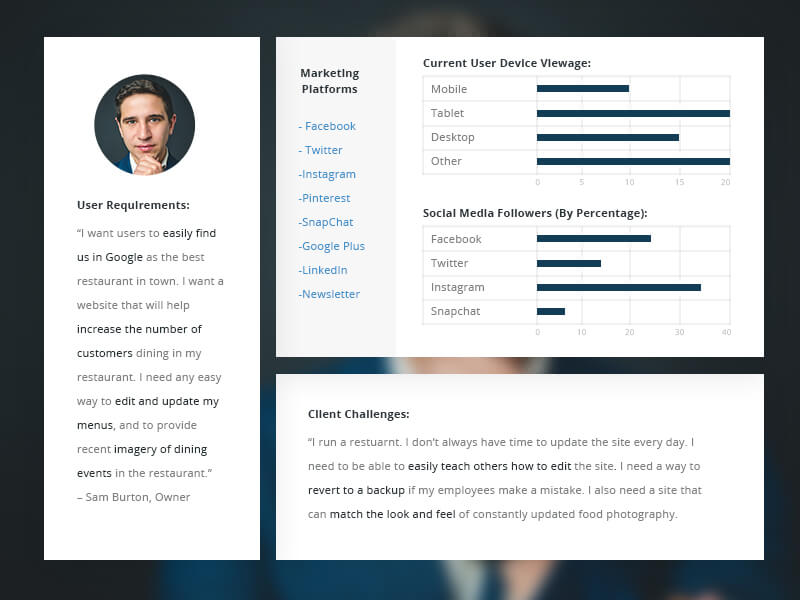According to HubSpot, a buyer persona (also known as a user persona or target persona) is a semi-fictional representation of your ideal customer based on market research and real data about your existing customers. Without a target buyer persona, it’s kinda like throwing spaghetti at the wall and hoping it sticks. With a clearly defined persona, you’re crafting the right message that will stick with the right readers.
Why leave your marketing up to chance? In order to create real connections that initiate action with your brand, you need to be targeting your marketing at a customer you know is a qualified lead—someone most likely to want or need your products/services. By specifically identifying and targeting this group or groups, you’ll be able to ensure the content you create is relevant to them.
If you’re part of your business’s marketing team or even working for an agency that does marketing work for clients, buyer personas are a great way to ensure everyone on your team is honed in on the same ideal customer.
How Personas Can Boost Your Content Strategy

Cater Your Brand Voice to What Your Persona Will Respond/Relate To
Your brand should have a voice that, when developed and executed well, will stand out to your persona. If your voice and language are able to connect with them, they’re more likely to engage with your company’s content, share it with their friends and ultimately convert.
Use Tools to Target Them Directly
To target your customer personas effectively, use tools like Facebook ads, AdWords, and targeted keywords in your blog posts. These tools allow you to reach your ideal audience based on specific characteristics and interests. By targeting the right keywords, you can ensure your content ranks well in search results, making it easier for your personas to find you.
Reach Them Where They’re At
In developing your target persona, you’ve probably realized what platforms they most likely use, enjoy and spend their time using. Do they check email every morning while drinking coffee? Try implementing an email campaign that’s sent during those prime morning hours. Do they love Instagram for visual social engagement? Step up your Instagram content to reach them there.
Create Topic Clusters Based on Your Persona
With your personas, you’ll be able to more effectively create content based on the things they want to read. Topic clusters are the future of content marketing and a great way to strategically organize your website’s content to cater to your audience. These clusters provide a better user experience on your website by connecting similar content to central pages about key topics. This is also great for SEO!
Creating a Buyer Persona

You might be wondering, what’s the best way to create a user persona? There’s three basic steps:
1. Envision
Dream big. Think of your favorite types of customers. Your best clients. Now imagine if you combined them into one great big super customer—your ideal customer. What is unique about them? What makes them stand out among other audiences? Do you have multiple ideal customers based on multiple service offerings or multiple needs for your products? Use the answers to these questions to narrow in on the right persona (or personas) for your company.
2. Research
Dig deep. Find out as many demographic and psychographic characteristics of your ideal customer that you can and lay them all out. Some great ways to gather persona research and data include:
- Interviewing or gathering testimonials from current or past clients
- Pulling website data from Google Analytics or other data tools about visitor demographics, who’s visiting what pages, who’s converting to a lead, etc.
- Review your contact list for consistencies and trends between contacts
- Review data about your social media followers on Facebook Analytics
3. Personify
Now it’s time to take your gathered characteristics and compile them into a personality profile. This can include a variety of facts like name, gender, age, ethnicity, family, education level, hometown, occupation, customer needs, communication preferences, how they prefer to read content, etc. You’ll want to place all of this information (and a stock photo of your new dream customer) into a visually appealing, easily accessible document for you (and your team) to reference. Your target persona should seem almost like a real person when you’re done.
4 Things to Include When Creating User Personas:
- General Background Information – You should start with the following details: first name, job title, location, age, family life and annual income. This can come from gathering demographic information and data about previous customers and will help to create the first layer of personal details.
- Goals and Priorities – This is where you’ll want to imagine you are your consumer. Ask yourself: What is the goal I’m looking to achieve by purchasing this product or service? What are the priorities in my life—my children? My health? Technology? Safety? Write these goals and priorities down, as they are the emotions that drive your consumer to make a purchase.
- Personal Challenges and Pain Points – Reflect back on the goals and priorities of your consumer. What might stand in the way of reaching those goals? What worries might keep them from converting? Write these pain points down. With these in mind, you can position your business as the hero, showing how you can directly remedy those pain points.
- A Photo of Your Persona – After you’ve written out all the details about your persona, you’ll want to select an image of your ideal client. Just close your eyes and imagine what they’d look like. The face you think of might even be based on a current or previous client, a TV show character or a friend. Then, find a stock image that fits what your brain pictured! This is a great way to tie all the details together with a bow and really personify your consumer.
Of course, you don’t have to stop there! There are many other details you can add to your personas to make them more detailed, such as quotes about their goals and challenges, common objections, how they get their information (social media, blogs, news websites, etc.), how they like to communicate, and more! These four focus areas are a great way to establish a solid foundation.
Also, a great way to create your first draft is to follow a user persona template, such as HubSpot’s, Hotjar‘s or Xtensio’s.
Persona Example: Small Business Sam
Small Business Sam is obviously a small business owner. He typically has been in business for 5+ years prior to seeking a marketing agency. He skews male, age 28 to 40, and is typically the breadwinner for his household. Sam wants to start using his website to equip his sales team with more qualified leads. He also wants to make sure that the website is easy to use, as he has little time to manage his website. Because of this, he is worried that his sales team won’t have the proper tools or training to handle more leads as the website starts to perform better. From this small amount of information, I know that we can help Sam out by providing him and his users with a clearly-defined conversion funnel. Additionally, we can integrate a CRM into the site and help Sam train his salespeople to handle the influx of leads.

Looking to take your online presence to the next level?






